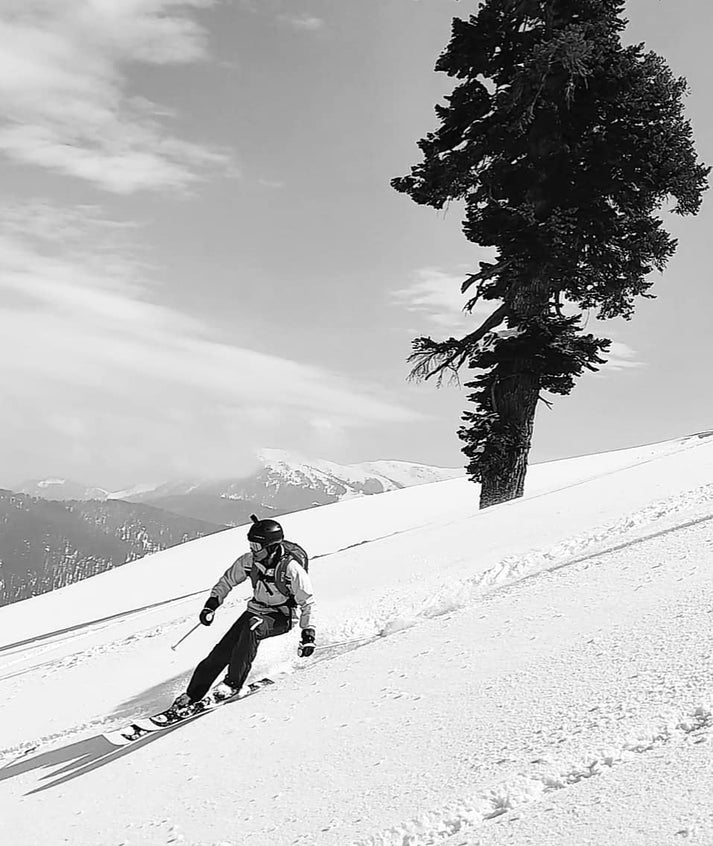Introduction to Skiing in Gulmarg, Kashmir
Are you interested in skiing in India?
The Himalayas boast some of the world's most stunning ski terrain, with Gulmarg in Kashmir standing out as the top choice for a ski resort that is at par with the west.

What to Expect from our Basic Skiing Course in Gulmarg
For those who have never skied before, here's an overview of what you can expect during the course.
1. Equipment Management
Upon settling into your cozy Gulmarg hotel, you'll meet your fellow course mates and instructors to gear up for the first time. Gulmarg weather in winter ranges from sunny to white-out conditions, with daytime temperatures averaging around -5 degrees Celsius. Ensure you bring proper clothing for the ski site.
You can find high quality apparel for skiing and mountaineering.
Both Waterproof Layers and Insulated Jackets.
Skiing is one sport here helmets are essential. Find them here.
a) Fitting Your Ski Boots
The first step is to fit your ski boots properly. Boots should not cut off circulation but should be snug enough to prevent your foot from moving around. The third buckle from the bottom, where the ankle bends, is crucial for a snug fit. Make sure all buckles are clasped tightly.
b) Attaching Boots to Skis
Next, you'll learn to attach your boots to your skis. Place the toe of your boot centered in the toe cup and push down firmly with your heel into the heel cup until it clicks. If you have trouble, adjust the heel cup position and ensure no snow or ice is stuck to your boot.
c) Gripping Your Ski Poles
Finally, learn the proper way to grip your ski poles. Wrap the strap around your wrist and hold it firmly between your fist and the pole, with the strap emerging from the underside of your fist.

2. Movement in Place
Before hitting the slopes, it's essential to manage movement in place to protect your skis and ensure control.
a) Holding Your Skis
To carry your skis, interlock the brake arms and place the skis on your shoulder, holding both poles in the other hand.
b) Turning in Skis
To turn, plant both ski poles firmly into the downslope and bring the nose of your ski diagonally inward to meet the nose of your other ski, forming a V-shape.
c) Traversing on Flat Snow
Lift your foot to take a normal step and place the opposite hand's pole into the snow when stepping down.
d) Ascending an Incline
Use the sidestep method, taking your skis perpendicular to the slope and using the edge of each ski facing the slope to push you up.
3. Snowplough and Movement
Your instructor will teach you the snowplough position for controlling speed and braking as a beginner. Push off with your poles and practice moving slowly down the slope in a straight line.
4. Snowplough Turns
Once comfortable with straight descents, learn snowplough turns to control your direction. Push the inner edge of the ski opposite to the direction you want to turn.
5. Stem Turns and Parallel Turns
Progress from snowplough turns to stem turns and eventually parallel turns. These techniques will help you gain speed and control, preparing you for more challenging slopes.
A Guide to Skiing in Gulmarg: Frequently Asked Questions
Why Enroll in a Skiing Course?
Enrolling in a skiing course with Skimo.in offers numerous benefits:
- Learn the basics from certified and experienced instructors.
- Master various skiing skills and techniques.
- Explore diverse terrain safely and enjoyably.
- Accelerate your learning curve with expert guidance.
Why choose Gulmarg?
Gulmarg, located in the Kashmir region, is India's premier skiing destination. It features one of the world's highest gondola and chairlift systems, offering stunning views and access to various slopes.
Best Months for Skiing in Gulmarg
The ideal months for skiing in Gulmarg are mid-January to mid-March, when snowfall is abundant, and temperatures are low enough to keep the snow intact.
Types of Skiing Courses Offered by Skimo.in
We offer a range of skiing courses to suit all levels:
- Basic Skiing Course for Beginners
- Intermediate Skiing Course
- Advanced Skiing Course
- Backcountry and Powder Skiing Course
- Always wear a helmet and appropriate safety gear.
- Be aware of your surroundings and other skiers.
- Start on easy slopes and gradually move to more challenging terrain.
- Take breaks and avoid pushing yourself too hard.
Understanding Ski Slope Colors
Ski slope colors indicate difficulty levels:
- Green: Easy slopes for beginners (gradient < 25%)
- Blue: Intermediate slopes (gradient 25%-40%)
- Red/Black: Challenging slopes for experienced skiers (gradient > 40%)

